A Full Technological Traceability System for Extra Virgin Olive Oil
Abstract
1. Introduction
2. Materials and Methods
2.1. EVOO Traceability
- Standing olive tree: application of the first waterproof coin shaped RFID tag with a central hole (RFID1) that was positioned on the trunk in the North direction and fixed with an iron nail (Figure 2A). This first tag was used to provide to the database information related to tree cultivar (Carboncella, Frantoio, Leccino), tree GPS point and other observations (notes). A total of 33 trees (11 trees per cultivar) were tagged.
- Olive harvest: application of the second kind of RFID tag (RFID2), a waterproof flexible band with two holes at the extremities fixed with a small cord on the crate (Figure 2B). The crates were used to transport the harvested olives at the olive oil mill. Each RFID2 was uniquely associated with one tree, thus preserving the association with the RFID1 information applied in the previous phase. Here were added the following information related to each crate: crate weight, olive maturity (high, medium, low), olive defects (high, medium, low) and other information (notes) and type of harvesting (mechanized, semi-mechanized, hand harvesting). In the present work the harvest was entirely semi-mechanized for all the cultivars.
- Olive pressing: information on the yield and type of olive oil extraction process. The extraction system used for the scope was a “Il Molinetto” compact continuous oil system from Pieralisi group (Ancona, Italy) and a two-phase centrifugal separator from Alfa Laval (Monza, Italy).
- Nutritional information of the olive oil printed on EVOO bottle label such as fats (saturated, monounsaturated, polyunsaturated), carbohydrates, proteins, salt and vitamin E.
- Final product: The QR code tag was printed on the external EVOO bottle label and protected by a “scratch and win” system. The “scratch and win” system is a gamification method that protects the QR code in order to allow the consumer who buys the product to obtain the reward. The Infotracing platform was implemented with a blockchain system. Once the consumer purchases the product, scratching the label and framing the QR code with a smartphone, he or she can receive, along with the product information, a digital token of €0.05, produced by the blockchain itself, which can be spent on the reference platform. The blockchain system ensures that the information inserted along the entire supply chain is tamper-proof [6].
- Final consumer: The QR code, once scratched, was scanned by the final consumer, and the infotracing information was read through a web link.
2.2. RFID Technology
2.3. App (Infoliva) for EVOO Traceability
- Main activity: the start page allows one to select the phase to be executed (standing olive tree or olive harvest).
- Standing olive tree (Figure 3B): through the “scan” button, the Bluetooth connection of the smartphone to the customized portable RFID reader is achieved. The device is in a waiting state ready to receive the tag RFID1 unique code that identifies the tree. When the RFID code is received, the app checks for the presence of the code. If it is an existing code, all data will be loaded and can be modified up to 2 h, while if it is a new code, the fields will be activated to enter the following information: cultivar (Carboncella, Frantoio, Leccino), GPS (automated inserted and unmodifiable), date (data; automated inserted and unmodifiable) and notes. Once inserted, the data will be saved on an internal database. Data updating and deletion functions have also been implemented and are available up to 2 h.
- Olive harvest phase (Figure 3C): as reported above, the scan button allows the reading of a RFID tag via Bluetooth. The procedure consists of the following: (1) reading the RFID1 positioned on the tree that needs to be harvested, (2) association of the plant tag to the related crates where the olives are collected, (3) adding the following information for each crate: crate weight, olive maturation (high, medium, low), olive defects (high, medium, low), date (data; automated inserted and unmodifiable), notes. Control procedures to verify the data consistence and coherence were implemented. As above described, data update and delete functions were also implemented and are available up to 2 h.
2.4. Econometric Analysis
- -
- arrangement of the nets under the tree to be harvested (CT): the work was carried out by 2 operators and included the drafting of 2 or more nets per tree in order to best cover the area where the olives will fall;
- -
- harvest time (HT): represents the work time necessary to detach the olives from the tree; it was carried out by 2 operators by means of the pneumatic combs from the ground;
- -
- olive accumulation time (AT): represents the time necessary to remove the nets from the harvested plant and gather the olives together in a point of the net before cleaning the twigs and leaves;
- -
- cleaning and unload time (UT): represents the time necessary for a gross cleaning from twigs and leaves of the olives collected and the unloading of the same in the crates;
- -
- delays (D): the whole time needed for mechanical delays as needed for service or machine repair, and personal delays as interruptions due to the operators, including rest breaks;
- -
- net productive time (NT): represented by the sum of all precedent elements without D;
- -
- gross productive time (GT): obtained by the sum of NT and D.
- Implementation of all the components necessary to set up the TTS (tag, reader, software, etc.), with the determination of the initial capital to be invested to set up the system.
- Application and use of the TTS assessing all the operations necessary for regular operation; detection of current costs to apply the tags in the traced objects (standing trees, crates of filled olives, derived oil), which must be marked along the production chain for complete traceability and the transfer of the stored data.
- Implementation and modernization of the TTS for receiving and reading the information stored in the field, in the farm and in the oil mill. The required investment amortization must be spread over several years of activity.
- Evaluation and verification of the benefits that the TTS application can generate within the production chain. Assessment of the economic convenience derived by the technology used.
3. Results and Discussion
3.1. Technological Traceability System
3.2. Economic Analysis
- Production yield;
- Pruning indications;
- Pests and diseases/treatments;
- Fertilization;
- Irrigation.
4. Conclusions
Author Contributions
Funding
Acknowledgments
Conflicts of Interest
References
- Galtier, O.; Dupuy, N.; Le Dréau, Y.; Ollivier, D.; Pinatel, C.; Kister, J.; Artaud, J. Geographic origins and compositions of virgin olive oils determinated by chemometric analysis of NIR spectra. Anal. Chim. Acta 2007, 595, 136–144. [Google Scholar] [CrossRef] [PubMed]
- García-González, D.L.; Luna, G.; Morales, M.T.; Aparicio, R. Stepwise geographical traceability of virgin olive oils by chemical profiles using artificial neural network models. Eur. J. Lipid Sci. Tech. 2009, 111, 1003–1013. [Google Scholar] [CrossRef]
- Muzzalupo, I.; Pisani, F.; Greco, F.; Chiappetta, A. Direct DNA amplification from virgin olive oil for traceability and authenticity. Eur. Food Res. Technol. 2015, 241, 151–155. [Google Scholar] [CrossRef]
- Ben Ayed, R.; Ben Hassen, H.; Ennouri, K.; Ben Marzoug, R.; Rebai, A. OGDD (Olive Genetic Diversity Database): A microsatellite markers’ genotypes database of worldwide olive trees for cultivar identification and virgin olive oil traceability. Database 2016, 2016, bav090. [Google Scholar] [CrossRef] [PubMed]
- Chatziantoniou, S.E.; Triantafillou, D.J.; Karayannakidis, P.D.; Diamantopoulos, E. Traceability monitoring of Greek extra virgin olive oil by differential scanning calorimetry. Thermochim. Acta 2014, 576, 9–17. [Google Scholar] [CrossRef]
- Violino, S.; Pallottino, F.; Sperandio, G.; Figorilli, S.; Antonucci, F.; Ioannoni, V.; Fappiano, D.; Costa, C. Are the innovative electronic labels for extra virgin olive oil sustainable, traceable, and accepted by consumers? Foods 2019, 8, 529. [Google Scholar] [CrossRef] [PubMed]
- Kalaitzis, P.; El-Zein, Z. Olive oil authentication, traceability and adulteration detection using DNA-based approaches. Lipid Technol. 2016, 28, 173–176. [Google Scholar] [CrossRef]
- Pereira, L.; Gomes, S.; Barrias, S.; Fernandes, J.R.; Martins-Lopes, P. Applying high-resolution melting (HRM) technology to olive oil and wine authenticity. Food Res. Int. 2018, 103, 170–181. [Google Scholar] [CrossRef] [PubMed]
- Sebastiani, L.; Busconi, M. Recent developments in olive (Olea europaea L.) genetics and genomics: Applications in taxonomy, varietal identification, traceability and breeding. Plant Cell Rep. 2017, 36, 1345–1360. [Google Scholar] [CrossRef] [PubMed]
- Papetti, P.; Costa, C.; Antonucci, F.; Figorilli, S.; Solaini, S.; Menesatti, P. A RFID web-based infotracing system for the artisanal Italian cheese quality traceability. Food Control 2012, 27, 234–241. [Google Scholar] [CrossRef]
- Regattieri, A.; Gamberi, M.; Manzini, R. Traceability of food products: General framework and experimental evidence. J. Food Eng. 2007, 81, 347–356. [Google Scholar] [CrossRef]
- Hsu, Y.C.; Chen, A.P.; Wang, C.H. A RFID-enabled traceability system for the supply chain of live fish. IEEE Int. Conf. Autom. Logist. 2008, 81–86. [Google Scholar] [CrossRef]
- Nguyen, S.D.; Le, N.N.; Lam, P.T.; Fribourg-Blan, E.; Dang, C.M.; Tedjini, S. A wireless sensor for food quality detection by uhf rfid passive tags. In Proceedings of the International Conference on Advanced Technologies for Communications (ATC), Ho Chi Minh City, Vietnam, 14–16 October 2015; pp. 258–263. [Google Scholar]
- Bernardi, P.; Gandino, F.; Lamberti, F.; Montrucchio, B.; Rebaudengo, M.; Sanchez, E.R. An anti-counterfeit mechanism for the application layer in low-cost RFID devices. In Proceedings of the Bucharest: 4th European Conference on Circuits and Systems for Communication, Bucharest, Romania, 10–11 July 2008; pp. 227–231. [Google Scholar]
- Bibi, F.; Guillaume, C.; Gontard, N.; Sorli, B. A review: RFID technology having sensing aptitudes for food industry and their contribution to tracking and monitoring of food products. Trends Food Sci. Technol. 2017, 62, 91–103. [Google Scholar] [CrossRef]
- Figorilli, S.; Antonucci, F.; Costa, C.; Pallottino, F.; Raso, L.; Castiglione, M.; Pinci, E.; Del Vecchio, D.; Colle, G.; Proto, A.R.; et al. Blockchain implementation prototype for the electronic open source traceability of wood along the whole supply chain. Sensors 2018, 18, 3133. [Google Scholar] [CrossRef] [PubMed]
- Antonucci, F.; Figorilli, S.; Costa, C.; Pallottino, F.; Raso, L.; Menesatti, P. A Review on blockchain applications in the agri-food sector. J. Sci. Food Agric. 2019, 99, 6129–6138. [Google Scholar] [CrossRef] [PubMed]
- Galvez, J.F.; Mejuto, J.C.; Simal-Gandara, J. Future challenges on the use of blockchain for food traceability analysis. Trac. Trends Anal. Chem. 2018, 107, 222–232. [Google Scholar] [CrossRef]
- Sperandio, G.; Biocca, M.; Fedrizzi, M.; Toscano, P. Economic and technical features of different levels of mechanization in olive harvesting. Chem. Eng. Trans. 2017, 58, 852–858. [Google Scholar] [CrossRef]
- Biondi, P. Meccanica Agraria. Le Macchine Agricole; UTET: Doolin, Italy, 1999. [Google Scholar]
- Timpe, D.; Olsson, L.; Sidén, J. Cost analysis of introducing a log identification system using RFID in the wood supply chain: A case study at a Swedish forest company. Am. J. Ind. Bus. Manag. 2012, 2, 128–135. [Google Scholar] [CrossRef][Green Version]
- Pallottino, F.; Biocca, M.; Nardi, P.; Figorilli, S.; Menesatti, P.; Costa, C. Science mapping approach to analyze the research evolution on precision agriculture: World, EU and Italian situation. Precis. Agric. 2018, 19, 1011–1026. [Google Scholar] [CrossRef]
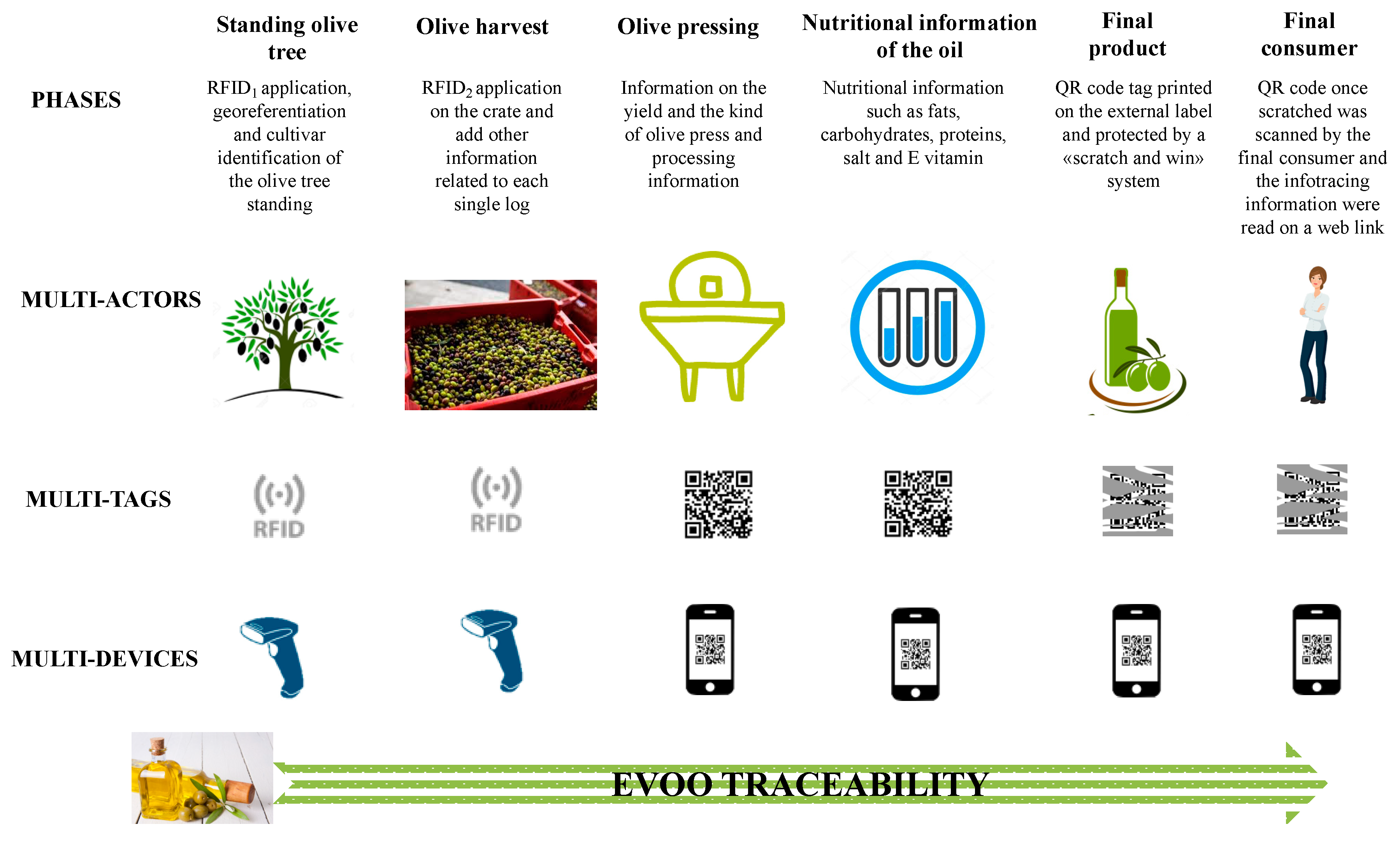
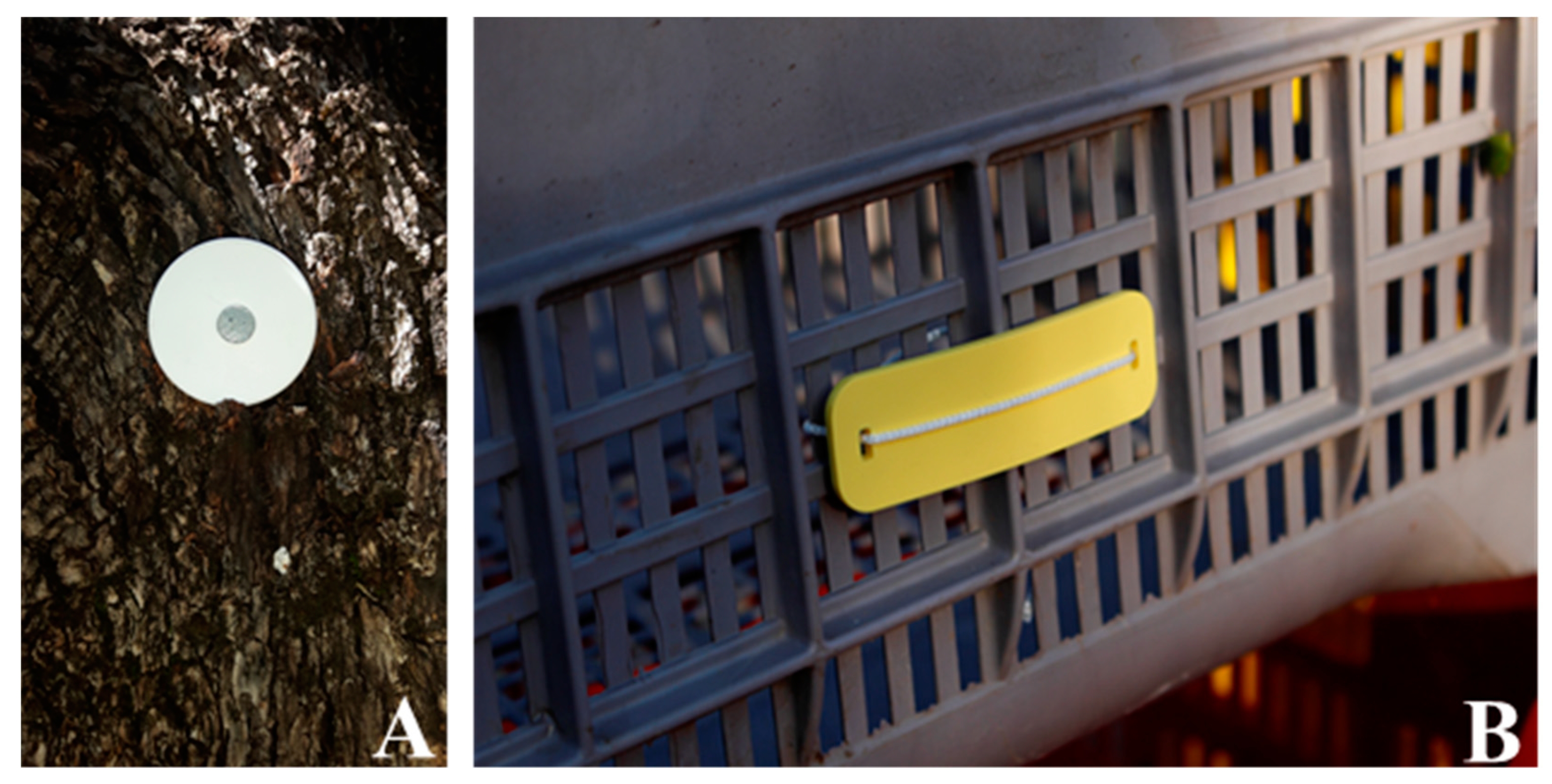
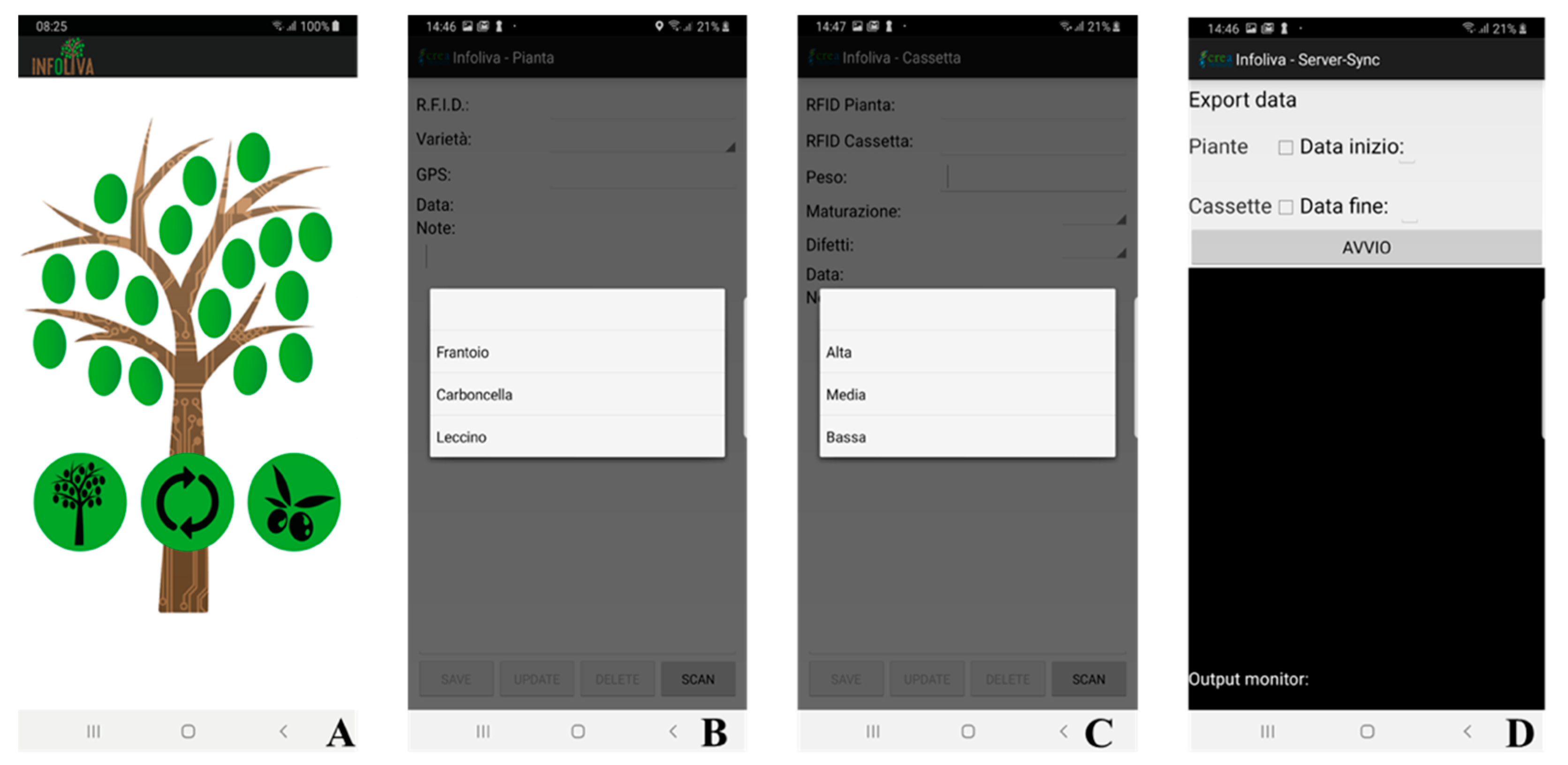
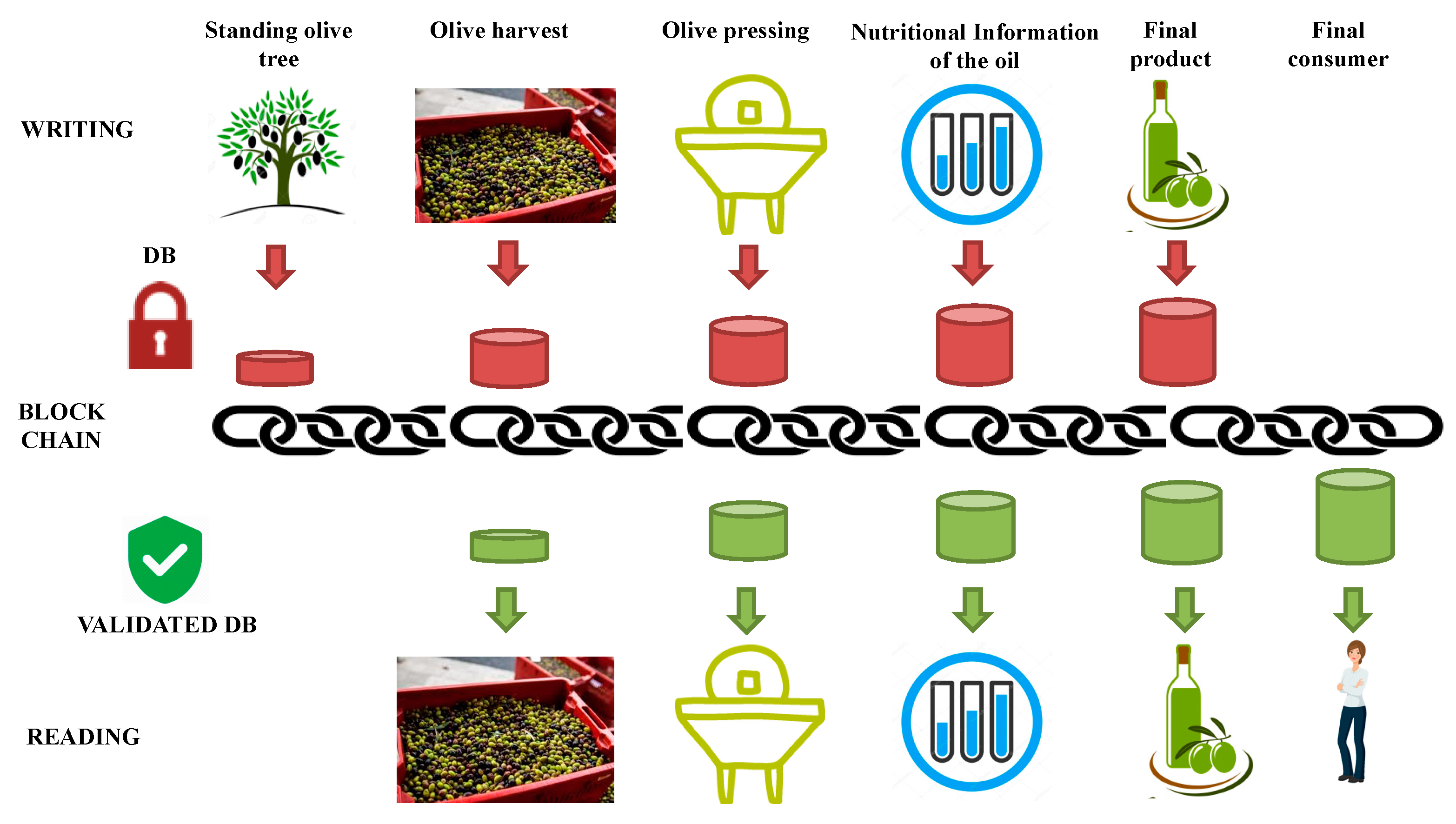

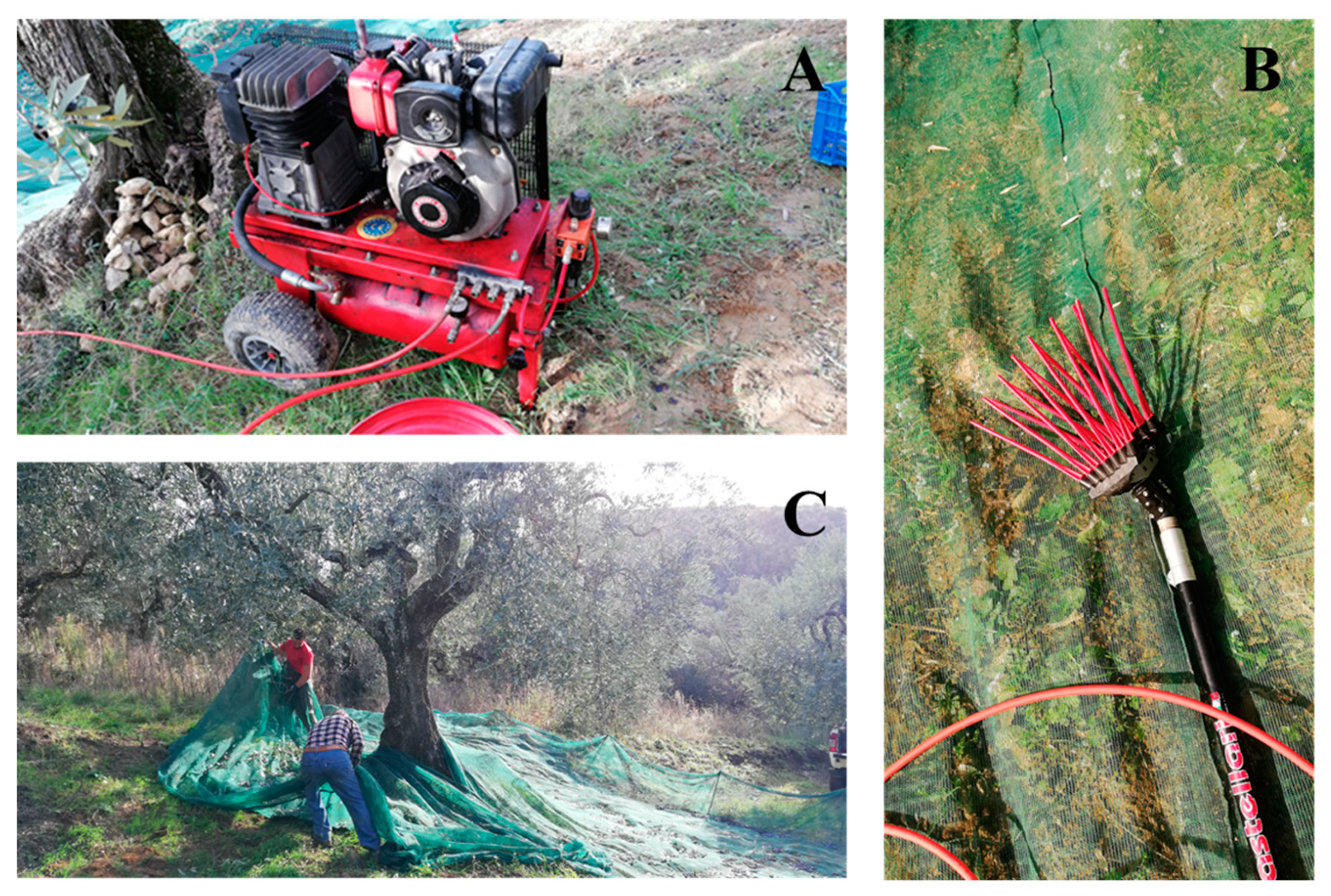

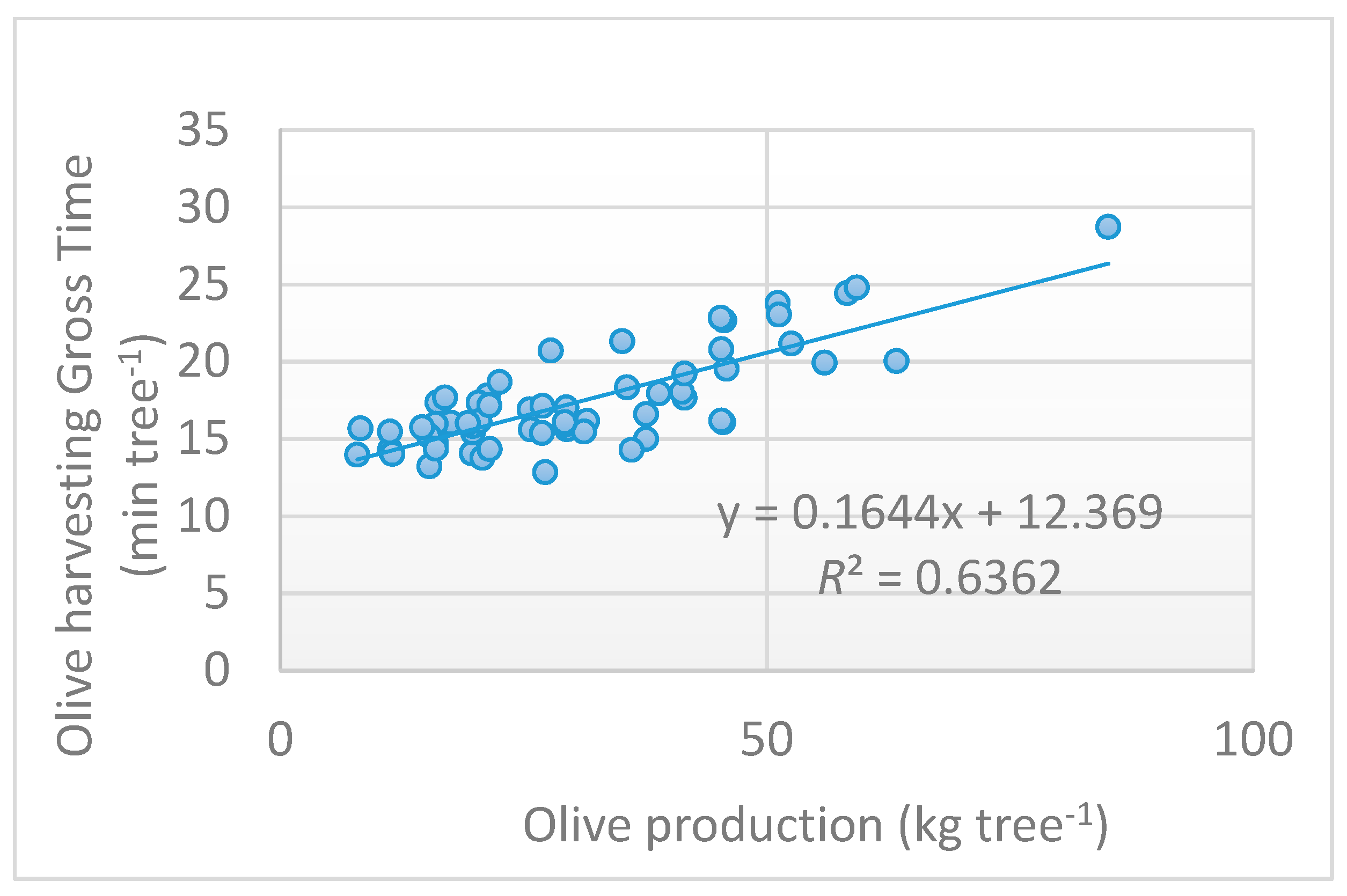
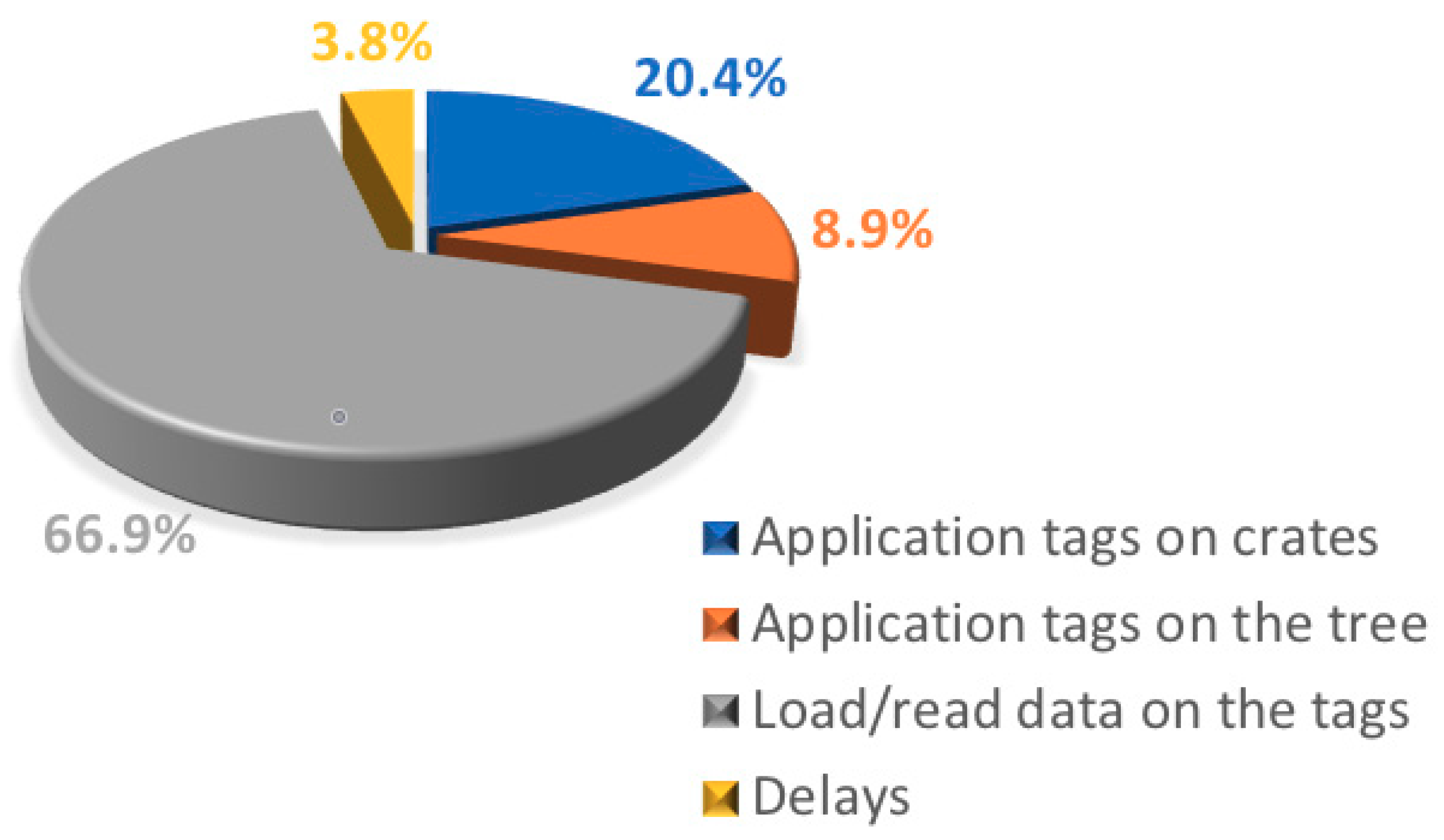
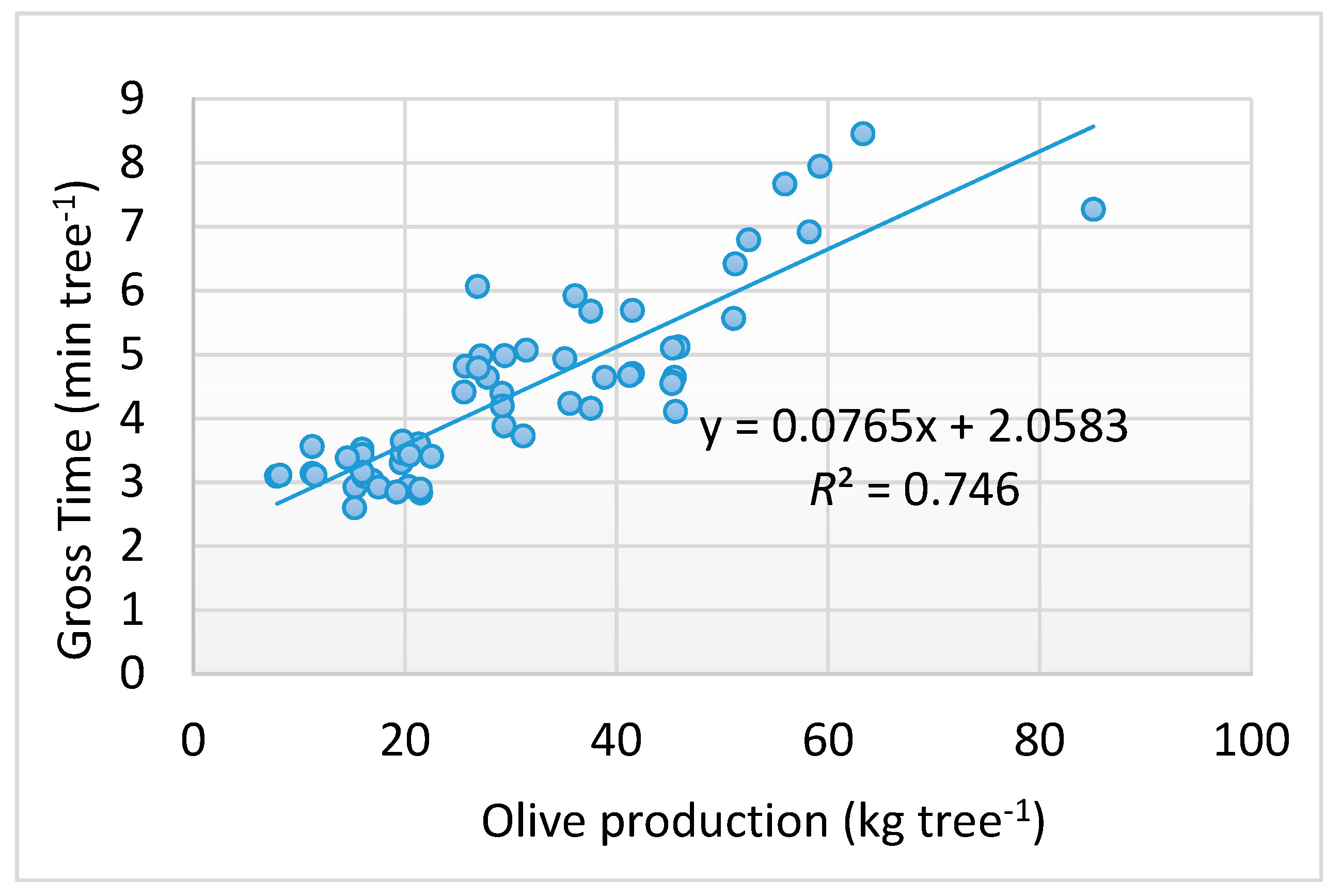
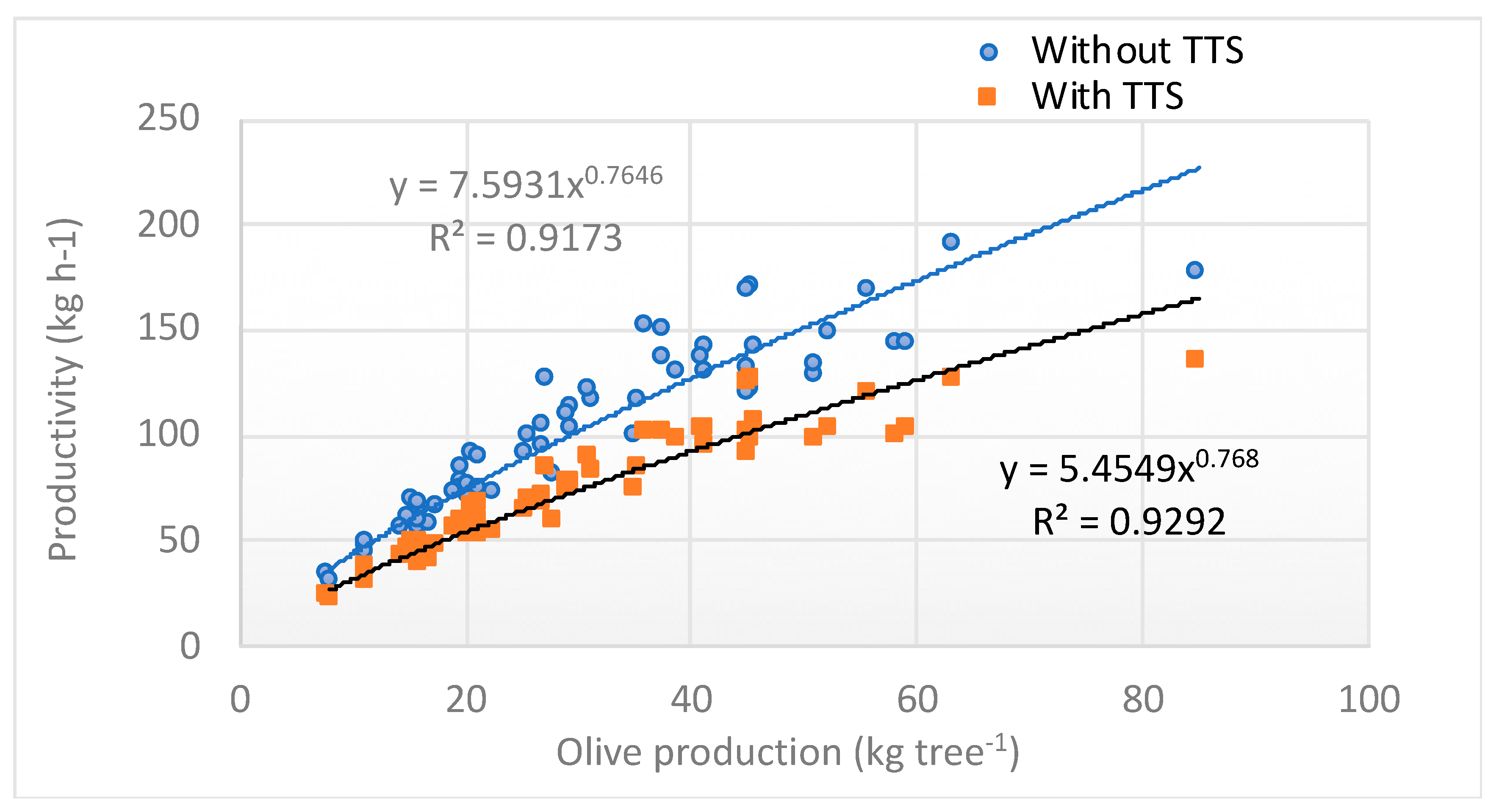
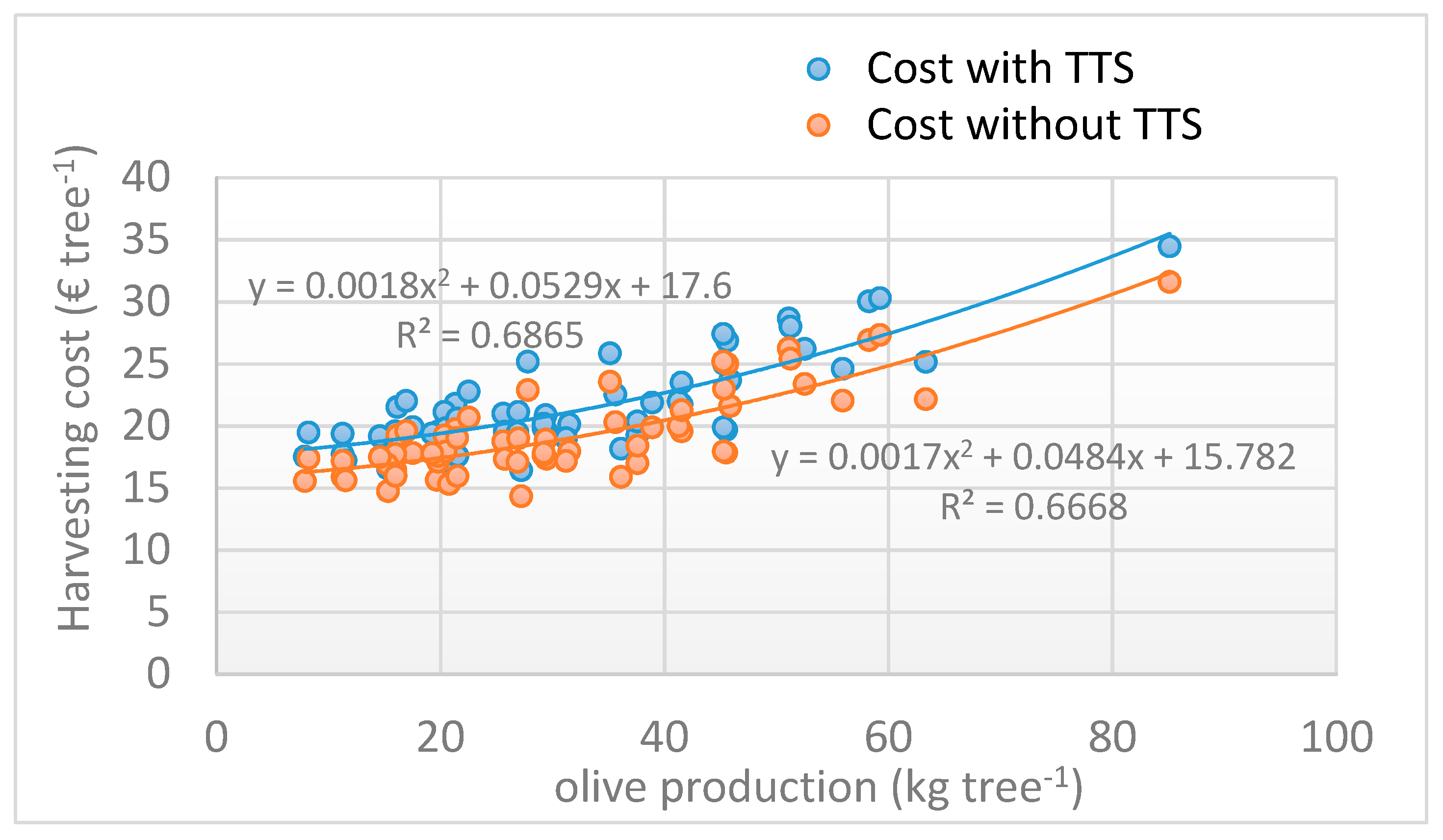
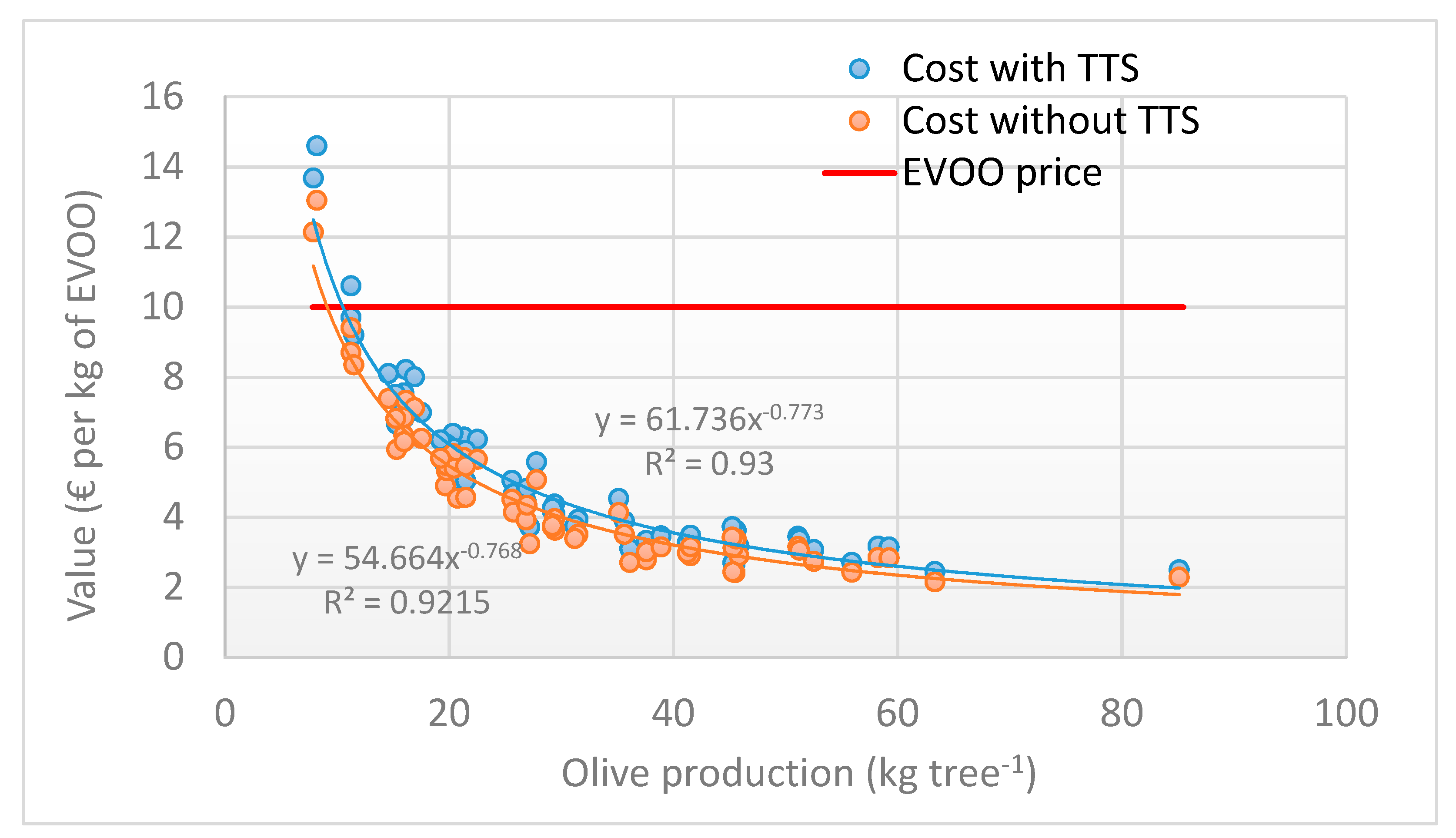
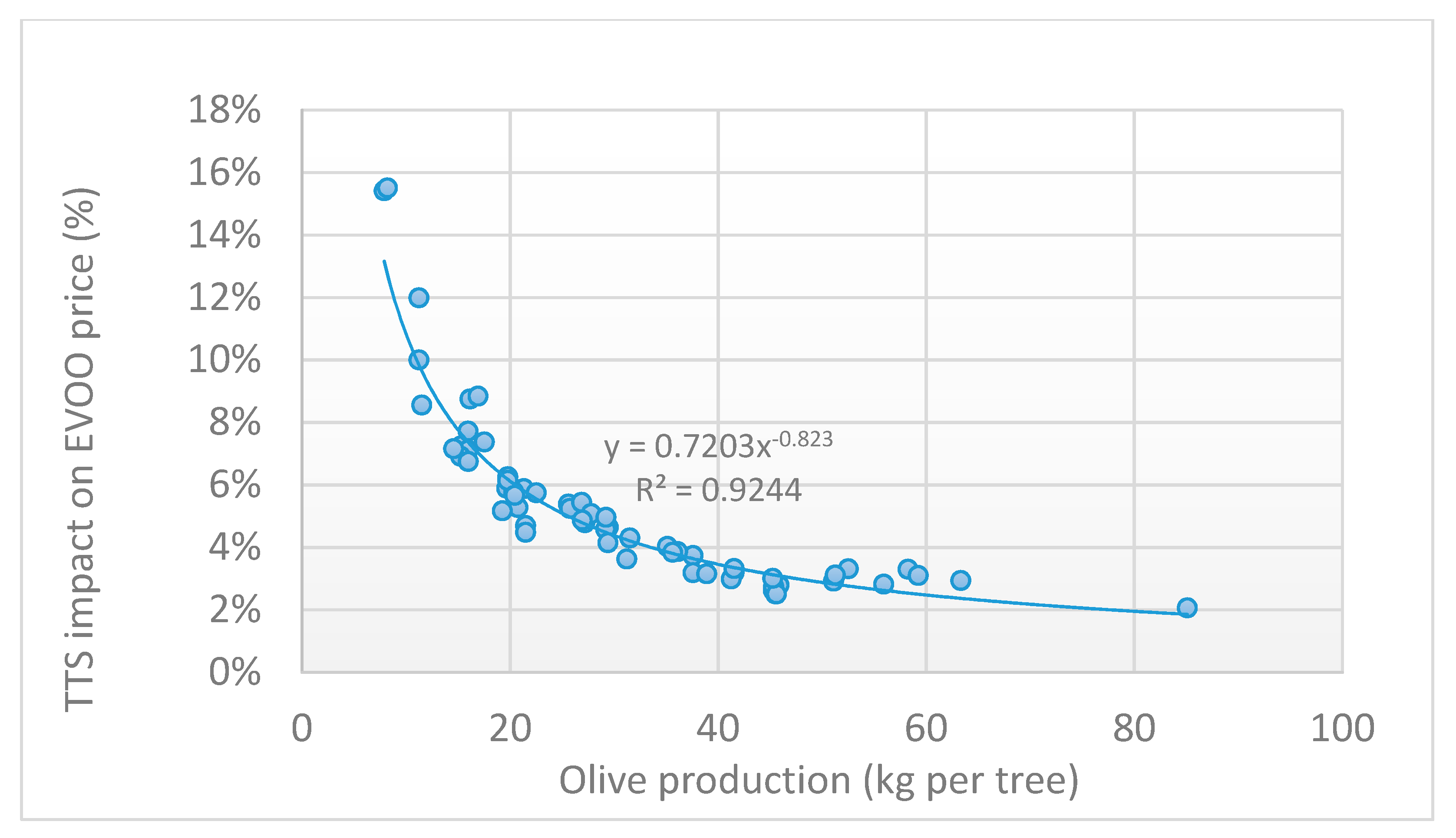
| Parameters | Diameter (cm) | Olive Production (kg) | Crates (N) |
|---|---|---|---|
| Average value | 50.67 | 30.9 | 1.73 |
| Standard deviation | 4.07 | 17.46 | 0.73 |
| Minimum value | 43.20 | 7.89 | 1.00 |
| Maximum value | 60.10 | 85.10 | 4.00 |
| Costs | Motor Compressor and Pneumatic Combs |
|---|---|
| Purchase price (€) | 2500.00 |
| Salvage value (€) | 313.00 |
| Service life (years) | 8 |
| Productive time (h year−1) | 480 |
| Power (kW) | 5.6 |
| Interest rate (%) | 4.0 |
| Fuel consumption (L h−1) | 1.14 |
| Lubricant consumption (L h−1) | 0.02 |
| Labor cost (€ h−1) | 15.00 |
| Machine cost (€ h−1) | 3.31 |
| Workers (N) | 4 |
| Harvesting yard cost (€ h−1) | 63.31 |
| Element | Values |
|---|---|
| RFID price (€) | 0.10 |
| RFID unit cost (€ for each per year) | 0.0125 |
| Reader price (€) | 150 |
| Reader cost (€ tree−1) | 0.46 |
| Software cost | open source |
| Data management (€ h−1) | 15 |
© 2020 by the authors. Licensee MDPI, Basel, Switzerland. This article is an open access article distributed under the terms and conditions of the Creative Commons Attribution (CC BY) license (http://creativecommons.org/licenses/by/4.0/).
Share and Cite
Violino, S.; Pallottino, F.; Sperandio, G.; Figorilli, S.; Ortenzi, L.; Tocci, F.; Vasta, S.; Imperi, G.; Costa, C. A Full Technological Traceability System for Extra Virgin Olive Oil. Foods 2020, 9, 624. https://doi.org/10.3390/foods9050624
Violino S, Pallottino F, Sperandio G, Figorilli S, Ortenzi L, Tocci F, Vasta S, Imperi G, Costa C. A Full Technological Traceability System for Extra Virgin Olive Oil. Foods. 2020; 9(5):624. https://doi.org/10.3390/foods9050624
Chicago/Turabian StyleViolino, Simona, Federico Pallottino, Giulio Sperandio, Simone Figorilli, Luciano Ortenzi, Francesco Tocci, Simone Vasta, Giancarlo Imperi, and Corrado Costa. 2020. "A Full Technological Traceability System for Extra Virgin Olive Oil" Foods 9, no. 5: 624. https://doi.org/10.3390/foods9050624
APA StyleViolino, S., Pallottino, F., Sperandio, G., Figorilli, S., Ortenzi, L., Tocci, F., Vasta, S., Imperi, G., & Costa, C. (2020). A Full Technological Traceability System for Extra Virgin Olive Oil. Foods, 9(5), 624. https://doi.org/10.3390/foods9050624










